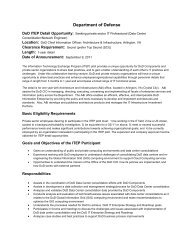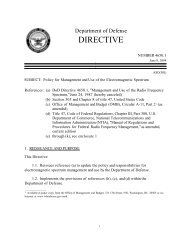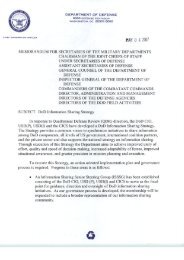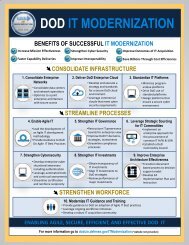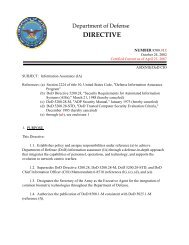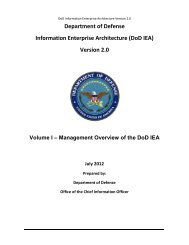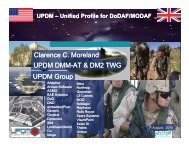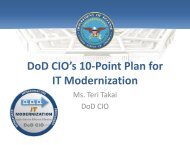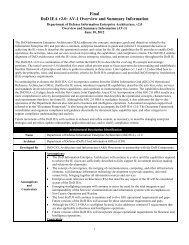DoD Architecture Framework Version 1.5 - Chief Information Officer
DoD Architecture Framework Version 1.5 - Chief Information Officer
DoD Architecture Framework Version 1.5 - Chief Information Officer
Create successful ePaper yourself
Turn your PDF publications into a flip-book with our unique Google optimized e-Paper software.
3 ARCHITECTURE USAGE<br />
3.1 THE VALUE OF ARCHITECTURES – DIFFERENT USES FOR DIFFERENT<br />
USERS<br />
The value of an architecture is realized through its usage. <strong>Architecture</strong>s are developed to<br />
support strategic planning, transformation, and various types of analyses (i.e., gap, impact, risk)<br />
and the decisions made during each of those processes. Additional uses include identifying<br />
capability needs, relating needs to systems development and integration, attaining IT<br />
interoperability and supportability, and managing IT investments. The following describes<br />
architecture usage at different portfolio levels:<br />
• Enterprise – <strong>Architecture</strong>s, particularly federated architectures, are used at the<br />
enterprise level to make better decisions that improve (1) human resource<br />
utilization, (2) deployment of assets, (3) warfighter investments, and (4)<br />
identification of the enterprise boundary (interfaces) and assignment of<br />
functional responsibility.<br />
• Mission Area – <strong>Architecture</strong>s are used at the mission area level to better<br />
manage capabilities within and across mission areas and improve investment<br />
decisions. <strong>Architecture</strong>s at this level are federated to support the development<br />
of enterprise architectures. They also provide roadmaps and descriptions of<br />
future or desired end states.<br />
• Component and Program – <strong>Architecture</strong>s are used at the component and<br />
program level to identify capability requirements and operational resource<br />
needs that meet business or warfighting objectives. Component and program<br />
architectures may then be integrated to support decision making at the mission<br />
level.<br />
<strong>Architecture</strong>s facilitate decision making by conveying the necessary information to the<br />
decision maker for the decision at hand as well as enabling the reuse of architecture information<br />
for additional needs. Rolling up component and program-level architectures to the enterprise<br />
ensures complete, actionable information for more reliable decisions. The following describes<br />
architecture data usage for different types of decisions:<br />
• Enterprise and Portfolio Management – Identifies opportunities to satisfy<br />
multiple operational requirements with a single, leveraged capability.<br />
• Capability and Interoperability Readiness – Assesses net-readiness to identify<br />
gaps in interoperable capabilities.<br />
• Acquisition Program Management and System Development – Represents<br />
system concepts, design, and implementation (as they mature over time),<br />
which enable and support operational requirements and provide traceability to<br />
those requirements. This process simplifies and integrates operational and<br />
system analysis, and improves both materiel and non-materiel solution<br />
analysis.<br />
• Modeling and Simulation – Models and simulates the implementation of<br />
mission threads and scenarios, thus providing an environment for thorough<br />
testing of identified use cases.<br />
3-1




